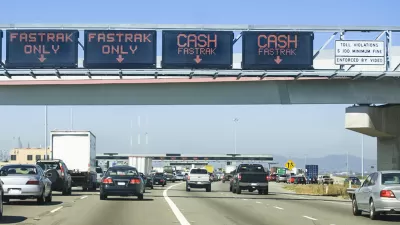"What program would you cut to continue the same level of transportation spending without raising the gas tax, e.g. cancer treatment programs, Head Start?," asks Streetsblog USA's Tanya Snyder after reading Sen. Bob Corker's (R-Tenn.) recommendation.
Sen. Bob Corker, who sits on the powerful Banking, Housing, and Urban Affairs, one of three committees responsible for measures to be included in the MAP-21 Reauthorization Act, sent a letter [PDF] on May 14 to the heads of the other two Senate committees: Environment and Public Works Committee and the Finance Committee, which at first glance might seem that he advocated increasing the federal gas tax to provide the necessary funds to fill the Highway Trust Fund shortfall, the difference between spending and gas tax receipts.
In the last few years, Congress has allowed the [Highway Trust Fund] to become one of the largest budget gimmicks in the federal government. Spending from the HTF has far outpaced [gas tax] revenues in recent years, taking us away from our traditional user fee, pay-as-you-go transportation financing model. Instead of enacting a permanent solution to this problem, we have transferred more than $50 billion of general fund money [$54 billion according to this NPR report] to maintain funding levels.
Corker's press release, which includes his letter, is even more direct, calling for "reestablishing (the) self-sustaining highway program" in the title.
He gets it! If you stopped reading there, you'd be very pleased that a senator is saying what we all know, that the "permanent solution", at least for this go-around of the transportation reauthorization act, is to bring the trust fund into solvency sticking to the "traditional user fee, pay-as-you-go transportation financing model."
Snyder takes it from here:
Then he lays out two options for solving the problem: “(1) increasing dedicated HTF user fees to match spending levels, or (2) reducing HTF spending to match dedicated HTF revenues.” He quickly dispenses with the first: “It is my belief that reducing spending to current HTF revenue levels would be damaging to our nation’s infrastructure, competitiveness, and economic growth.” Good show, Senator! So that leaves us with increasing the user fee, correct?
Not so fast. “Another alternative that would at least make Congress accountable for the increased spending is to offset HTF spending that exceeds revenues by reducing other government spending by an equal amount,” he wrote.
The "third strategy", off-setting the general fund transfers [see his press release], does nothing to restore the user-pay system that the Highway Trust Fund is based on. Snyder suggests that the Corker strategy would result in "lawmakers end(ing) up cutting cancer treatment programs and Head Start and meals on wheels. All to make sure drivers don’t have to pay their own way."
Seems like another gimmick to me.
FULL STORY: Sen. Bob Corker Sets Up for Gas Tax Increase, Yanks the Football

Alabama: Trump Terminates Settlements for Black Communities Harmed By Raw Sewage
Trump deemed the landmark civil rights agreement “illegal DEI and environmental justice policy.”

Study: Maui’s Plan to Convert Vacation Rentals to Long-Term Housing Could Cause Nearly $1 Billion Economic Loss
The plan would reduce visitor accommodation by 25% resulting in 1,900 jobs lost.

Planetizen Federal Action Tracker
A weekly monitor of how Trump’s orders and actions are impacting planners and planning in America.

Wind Energy on the Rise Despite Federal Policy Reversal
The Trump administration is revoking federal support for renewable energy, but demand for new projects continues unabated.

Passengers Flock to Caltrain After Electrification
The new electric trains are running faster and more reliably, leading to strong ridership growth on the Bay Area rail system.

Texas Churches Rally Behind ‘Yes in God’s Back Yard’ Legislation
Religious leaders want the state to reduce zoning regulations to streamline leasing church-owned land to housing developers.
Urban Design for Planners 1: Software Tools
This six-course series explores essential urban design concepts using open source software and equips planners with the tools they need to participate fully in the urban design process.
Planning for Universal Design
Learn the tools for implementing Universal Design in planning regulations.
Caltrans
Smith Gee Studio
Institute for Housing and Urban Development Studies (IHS)
City of Grandview
Harvard GSD Executive Education
Toledo-Lucas County Plan Commissions
Salt Lake City
NYU Wagner Graduate School of Public Service



























